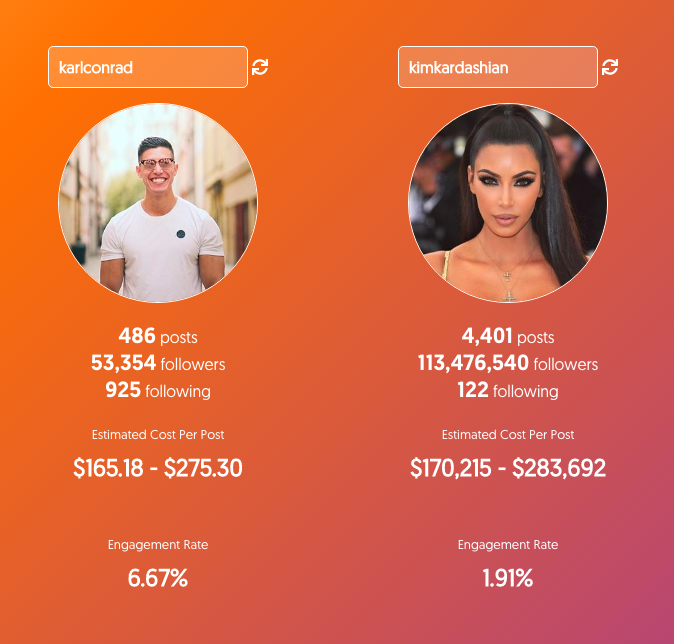It’s very common to associate influencer marketing campaigns with celebrities that have large fan bases. We see the Kardashians promoting beauty products on Instagram and know that partnership must have cost a fortune. While that’s likely true, the other reality is that influencer marketing doesn’t have to include household names and six figure budgets, in order to be successful. In this post, I will outline macro vs micro influencers, and help you choose what partnerships will be more successful for your brand marketing.
Micro influencers are relatable people that have loyal audiences centered around a particular niche. These people have less followers than their macro counterparts, but also tend to have higher engagement rates with their followers. Macro influencers, on the other hand, are famous people and celebrities who have a large following consisting of various demographics.
There is a new trend towards working with Micro Influencers. For example, YouTubers like Karl Conrad, have built a following of tech enthusiasts by regularly producing video content reviewing the latest technology products. These micro influencers are typically more affordable, easier to access and oftentimes, produce higher engagement.
There are a few reasons for the higher ROI that marketers can expect when working with micro influencers.
A MORE FOCUSED AUDIENCE
Celebrities who have gained popularity from working within the entertainment industry, tend to appeal to the masses. They attract a large group of diverse people who have varying interests and purchasing patterns. Not all of Kim Kardashian’s followers look to her as an authority in beauty, despite the paid influencer marketing campaigns she’s secured due to her following.
In the example of Karl Conrad, a YouTuber creating technology vlogs, he has an audience that views him as an expert in technology recommendations. He has positioned himself as a thought leader on the topic of tech products and his followers look to him when making decisions about whether to purchase the latest iPhone.
The reason why his followers value his opinion is because they seem his as an authentic, relatable leader. It is this authenticity that micro influencers provide that sets them apart from household names and celebrities. Their followers are able to relate and connect to them on a level that is unattainable with macro influencers.
Influencers with large follower counts certainly get more likes than micro influencers. However, when it comes to meaningful comments, sales, traffic, offline relationships, and in person events, micro influencers are the clear winners. They are more authentic in their storytelling and content. They are thought leaders in their niches and hence their followers are way more engaged and connected to them.
By working with a micro influencer that is creating content relevant to your brand, you can have more confidence that their followers are drawn to the influencer’s beliefs, opinions and authority within that industry.
HIGHER ENGAGEMENT
When evaluating macro vs micro influencers for your brand, followers don’t give you any right answers. A macro influencer typically has a following of 1 million or higher, where as a micro influencer has an audience ranging from 1000-100,000 followers. It seems contradictory to think that the influencer with less followers will have higher engagement but it’s true.
The latest research on Instagram’s platform has found that engagement rates drop as the number of followers increases. Accounts with less than 1,000 followers have an engagement ratio (likes divided by number of followers) of 8%, those in the 1,000-10,000 follower range receive about 4% engagement and accounts with 1 million-plus followers, are receiving less than 2% engagement on their posts.

Influencer Marketing Hub’s engagement estimator proves this to be true. Even though Karl Conrad has significantly less followers than Kim Kardashian, his engagement rates are 6x higher.
A study by HelloSociety found that micro-influencers are able to generate 60% greater engagement than other campaigns. The main reason for is that they are able to create a stronger bond with their followers. So their recommendations are trusted and valued more.
COST EFFECTIVE
Influencer marketing is a balancing act between reach and relevance; however, rates per post are most often determined by the size of the audience. Celebrities can charge up to $187,500 for a post on YouTube, $75,000 on Instagram and $30,000 for a post on Twitter. If you look at micro influencers on Instagram, on average they will charge around $180 per post. You might also be interested in checking out our blog post on How To Pay A Micro Influencer.
This means that not only does your marketing budget stretch further, but you can engage with multiple micro influencers for your campaign instead of one influencer who costs top dollar.
Look at it like this; would you rather spend $10,000 on one celebrity sponsored post, or spread out that money to 20 different micro influencers who are guaranteed to target and highly influence the exact audience you are looking for?
EASIER TO WORK WITH
It shouldn’t come as a surprise that getting a reply from Karl Conrad will be easier than hearing back from Kim Kardashian, but it goes further than the time saved from your outreach efforts. Micro influencers typically have less demands when it comes to their influencer marketing partnerships and will be less constricted by the types of content and brands they can work with.
They are still in the spot where they rely heavily on word-of-mouth and their reputations in order to grow their personal brand, so it is highly likely that they will be pleasant to work with in order to get more work and a good impression on their name.
These are the key factors shaping the effectiveness of influencer marketing campaigns and should be considered when making the decision to work with a macro vs. micro influencers.


